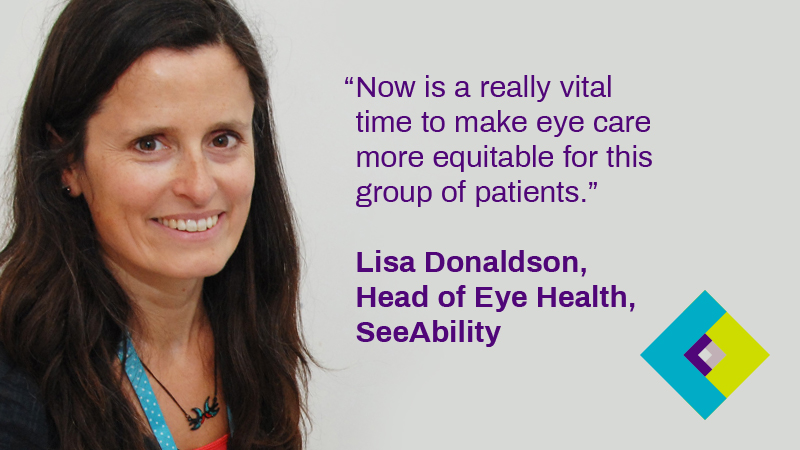Refreshed clinical pathway for People with Learning Disabilities now available
18 September 2020
Over 1.2 million people in England have a learning disability and face significant health inequalities compared with the rest of the population, however despite experiencing greater ill-health, people with a learning disability often experience poorer access to healthcare. Patients with learning disabilities are known to be significantly more likely to have serious sight problems at a younger age than the general population, however this group is less likely to receive timely and appropriate eye care.

Patients with learning disabilities are a ‘hard to reach’ group and part of the reason they are known to suffer health inequalities is because health promotion information is not accessible to them. Therefore, it is essential that communication is a key focus for the pathway, to ensure that people with learning disabilities, along with their families and carers, are aware of the service and how it can be accessed.
The Covid-19 pandemic has affected access to eye care for all patients, but has had a particular impact on people with learning disabilities who rely on routine care to identify the emerging eyecare issues which are more common amongst this group.
LOCSU has been working in partnership with SeeAbility, Mencap, ABDO and WOPEC to refresh the pathway and training resources to meet the needs of both patients and practitioners:
- Pre-appointment preparation – downloadable resources available for patients from the SeeAbility website describing what will happen at the appointment, with forms completed before the appointment so practitioners are aware of the patient’s situation in advance
- Tailored appointments – additional time at the appointment and adjustments to clinical procedures to meet patient needs
- Post appointment feedback – easily readable report provided after the appointment, so that patients and their carers understand the outcome, and what future action is needed
- Online resources – information explaining various eye conditions available on the SeeAbility website, in easily downloadable and readable formats
- Full management in primary care – support more patients to be fully managed within an optical practice, avoiding unnecessary referrals to hospital eye services (HES)
- Local integration between primary and secondary care so that patients who usually receive their care within HES to be transferred to the primary care service and also enabling children in special schools to transition into the service for the continuation of their eye care, when the time is right. Patients can be referred into the service following their learning disability Annual Health Check (AHC) with their GP, with information provided back to the GP following the appointment
- Communication – SeeAbility’s network of Eye Care champions can support the communication of new commissioned services to the target audience, as well as being able to support the NHS commissioning process if required
The pathway is intended to provide individualised care for patients with moderate to severe learning disabilities; those with mild learning disabilities may access GOS sight tests in the usual way with minor reasonably adjusted support. It is important to note that the principles of the pathway can be applied to a broader population if need is identified, for example people with autism who do not have a learning disability, and people with neurological and mental health conditions, such as dementia.
Lisa Donaldson, Head of Eye Health at SeeAbility said “The Covid-19 pandemic has reduced access to eye care for people with learning disabilities, so this is a really vital time for us to step up to the challenge of making eye care more equitable for this group of patients. We are fully committed to supporting LOCSU and the LOCs with the commissioning process as well as helping to communicate new services to the target audience once they are commissioned.”
“The Association of British Dispensing Opticians (ABDO) is extremely proud to have been involved in the work on this new pathway for people with learning difficulties,” said Max Halford, Clinical Lead for ABDO. “Dispensing opticians have always played an important role in the eyecare of this group of patients and it is a great step forward to see a pathway of care introduced which will allow practitioners to work together to ensure the best possible visual outcomes” added Max.
Zoe Richmond, LOCSU Interim Clinical Director said “By improving access for this population to regular and routine eye care, there is the potential to prevent loss of sight, help patients make the best use of the vision they have and for carers and supporters to understand what the person can see. This in turn should improve outcomes and independence for people with learning disabilities, with the benefits seen across the local health and social care system.”
LOCs should access the Members Area of the website to download the Pathway Documentation including the pathway diagram, pathway guideline, Service Delivery proposal and links to SeeAbility resources.
A case study has been created as a tribute to the late Sally Rose who, despite losing almost all of her vision, helped to pioneer an early pathway for people with learning disabilities.
Click here to access the podcast featuring SeeAbility Head of Eye Health Lisa Donaldson and SeeAbility Eye Care Champion Grace McGill, with LOCSU’s Richard Whittington and Zoe Richmond.

